How to plant lilies in the open ground in spring and properly care
Lilies are one of the most popular flowers in summer cottages, which attract attention with their delicate, colorful and abundant flowering. Moreover, they give their own touch to the range of smells in the garden.
As a rule, these flowers are planted in autumn, but recently spring planting of lilies in open ground has become popular. But in order to grow beautiful flowers, you first need to choose and buy high-quality planting material, keep it until it is planted in a permanent place in the garden, plant it, and then properly care for the flower until autumn. All this is discussed later in the article.

Content
Popular types and varieties of lilies
As a rule, lilies, depending on their origin, are divided into the following groups of hybrids:
- Asian;
- Martagon;
- Candidum;
- American;
- Long-flowered;
- Tubular and Orleans;
- Oriental (orientalia).
There are also interspecific hybrids of lilies:
- LA hybrids (Asian + longiflorum);
- OT hybrids (Orienpits - eastern + tubular);
- LO hybrids (long-flowered + oriental);
- OA hybrids (oriental + asian).
Video: species, varieties and hybrids of lilies
How to choose lily bulbs
The choice of planting material should be approached with the utmost seriousness if you want to get a flower that will delight you with abundant flowering and decorate your flower bed until autumn.

Here are some important points to pay attention to when choosing lily bulbs:
- The optimal size of the diameter of the bulb is 2-3 cm. If the bulbs are smaller, then most likely they are after forcing, which means that you will not get flowering immediately, but only in the 3rd year.
- The bulb should be firm to the touch, and the scales should not fall apart. Excessive dryness and looseness are signs of low-quality planting material.
- The specimen should be free of any obscure spots or signs of rot.
- Donets should be in good condition, without damage, and the roots should be alive, not dry or completely rotten.
- The sprout should preferably sleep. If it has already begun to stretch, then such a bulb will have to be grown at home in a pot (in the case of an early purchase) or immediately planted in open ground (if you bought it in May).
- The color of the bulb does not matter. The color is influenced by the type and variety.
How to keep lilies before planting
If you bought lily bulbs in advance, or they were presented to you on March 8 (yes, it happens), then you should take care of the problem of preserving them before planting in open ground.
It is best to store lily bulbs in the refrigerator, in the cellar, or in the basement, where the temperature ranges from 2-6 degrees.
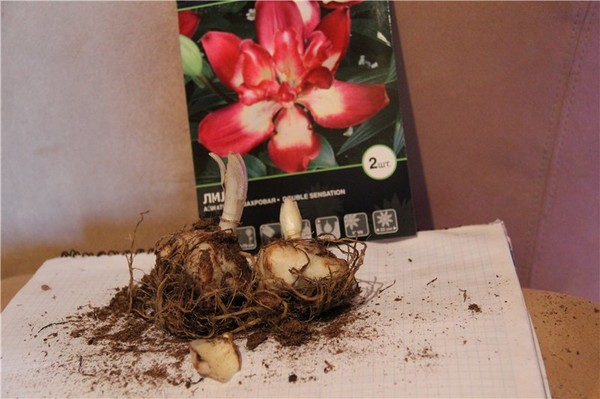
Be sure to periodically observe the bulbs during storage. If suddenly they start to sprout too early, then you need to plant them in a pot, so to speak, for seedlings. More details about this method of sprouting bulbs will be described later.
Video: how to plant lilies with sprouts in spring
Growing lily seedlings (preliminary early planting of bulbs in a pot)
As a rule, lily bulbs are always immediately planted in open ground, but in some cases it is useful to germinate them at home, so to speak, by planting them on seedlings.
This method has its advantages. You will immediately see how the flower takes root and takes root, whether it needs feeding. Plus, you will have the opportunity to know in advance where to plant the grown flower bulbs.
Before planting a lily bulb for germination in a pot, it must first be processed. To begin with, it should be well cleaned of the earth and assess its condition by its appearance. Now you need to soak the onion (only the onion, you do not need to immerse the sprout) in a slightly pink 1% solution of potassium permanganate at room temperature, and the water should be settled. There are different opinions about the duration of the soaking procedure: someone does it for 1.5-2 hours, and someone does it within a few minutes.
It is recommended to pre-disinfect the soil for planting (steam in a double boiler or fry in the oven / microwave).
It is advisable to choose a transparent container so that it is convenient to control the moisture content of the substrate. It will be good if you make drainage holes not only at the bottom, but also on the side.
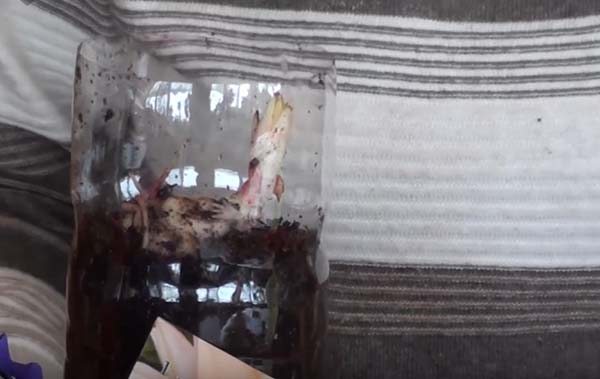
It is impossible to plant a lily bulb in a pot deeply. This is already when planting in open ground, it should be buried at its 3 heights, when planting in a pot, it is enough to fill the bulb up to the tip of the sprout.
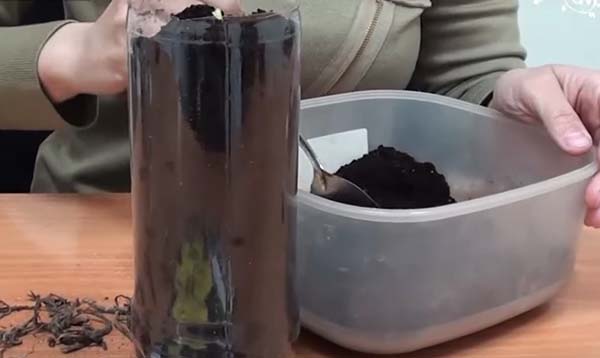
Advice! You can make a multi-layer bedding for better growth of lily bulbs. Pour ordinary soil down, then make a pillow of river sand, on which to put the bulb itself, and cover it with the same soil on top.
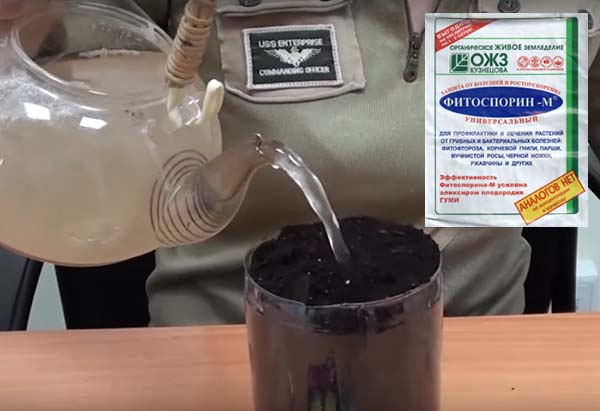
After planting, the earth from above does not interfere with spilling water or solution phytosporin (to suppress the causative agents of fungal diseases) Moreover, this is necessary if you refused to disinfect the soil by calcining it at high temperatures.
The most lighted windowsill or loggia is suitable as a place for further growing lily seedlings.
After planting the lily bulbs in the pot, further care consists in regular watering as the soil dries up, that is, approximately 1 watering every 5-7 days will be enough. Top dressing is not necessary.
If you want to continue growing lilies in a pot at home, then keep in mind that this is still a street flower, and it requires slightly different conditions, which are rather difficult to organize at home, so it is highly likely to die.
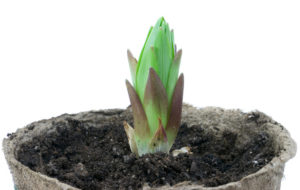
As for the timing of planting lilies, which were warm on your windowsill at home and did not experience night and day temperature fluctuations, they need to be planted in the garden in a permanent place a little later than with direct planting of bulbs in open ground, in other words, only along the passage of all possible return frosts, that is, at the end of May - at the beginning of June. When the time is right, carefully remove the sprouted lily bulbs along with the soil from the pots and plant them outdoors in a flower bed.
Video: sprouting lily bulbs in spring in pots
Technology for planting lily bulbs in open ground
Optimal planting times
The optimal time for planting lily bulbs in open ground should be selected in accordance with the climate of your region and weather conditions. In any case, you can start planting from May. By this time, the ground should have warmed up enough, and the probability of return frosts will come to naught.
According to the lunar calendar in 2021
Choosing the best date for planting the bulbs can help you Moon calendar.
Important! Planting lily bulbs in a pot (for germination at home) is also recommended in accordance with the lunar calendar.
So favorable days for the spring planting of lily bulbs in 2021 according to the lunar calendar are:
- in March - 8-12, 26-31;
- in April - 7, 9-15, 17-22, 27-30;
- in May - 2-6, 9-12, 20, 21, 29-31;
- in June - 7-9, 11-14.
Unfavorable days according to the lunar calendar for 2021 for planting lily bulbs in spring, the following dates are (days of the Full Moon and New moons, as well as the period when the Moon is in Aquarius, because it is a barren and dry sign -italicized):
- in March -9-10, 13, 28;
- in April -5-6, 12, 27;
- in May -2-4, 11, 26, 30-31;
- in June -10, 24, 26-27.
Site selection and soil preparation
Depending on the variety, lilies require different degrees of light to grow successfully in the garden. Asian, tubular and LA hybrids will only thrive in sunny or very light penumbra. Eastern and martagons are not a sin to plant in shady places. You can find out more about the lighting requirements by reading the instructions on the packaging of the bulbs you have purchased or are about to buy.
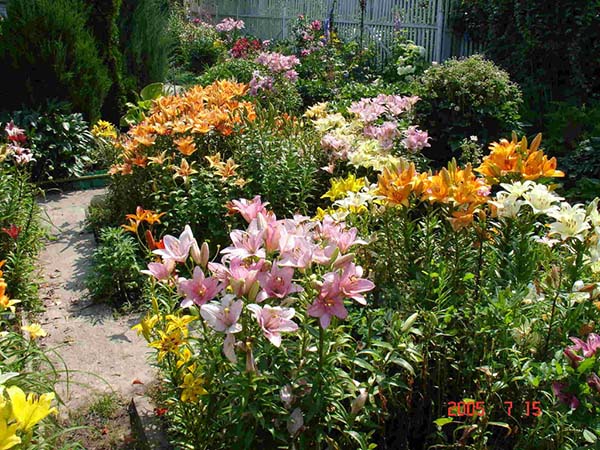
For planting lilies, it is important to find a place well protected from the wind in the garden. It would be great for it to blow a little. If you plant flowers in a corner completely closed from blowing, this can adversely affect their development, namely: the humid air will stagnate excessively, and the bulbs will simply trample and rot.

The main requirement of lilies for the soil in which they will be planted, as for most bulbous flowers, is good soil drainage. For example, an overly light and sandy soil will provoke a constant lack of moisture for the growth of bulbs. And for example, heavy and clayey soil will not allow it to develop normally, and the flower will rot.
To make the soil more nutritious and suitable for growing lilies, you should add peat to the sandy soil, and again peat and additional sand to the dense and clayey soil (each one bucket per 1 square meter of flower beds).
Too acidic soil is also not suitable, therefore, to reduce its acidity, you should use wood ash or dolomite flour.
If you want the soil to become just perfect and as fertile as possible, then do not be stingy and add a bucket of excellent humus or rotted compost to the planting site. You can also use mineral fertilizers, for example, use potassium sulfate and superphosphate.
Planting bulbs
The basic rule for planting almost all bulbs is that the planting depth of the bulb should be equal to 3 times the height of the bulb itself. If your lily bulb is 3 centimeters high, then the depth of the planting hole, more precisely, the hole should be 9 centimeters.

When making a planting hole for lilies, keep in mind that drainage must be present at its very bottom. You can put expanded clay, broken brick, gravel or something else there. After such drainage, a special pillow should be made from fertile soil (just do not put the bulb directly on the expanded clay drainage), in which the flower will grow.
The distance between plantings of lilies should be in the region of 20-40 centimeters. Such a planting scheme will provide an opportunity for the normal development of the plant's root system.
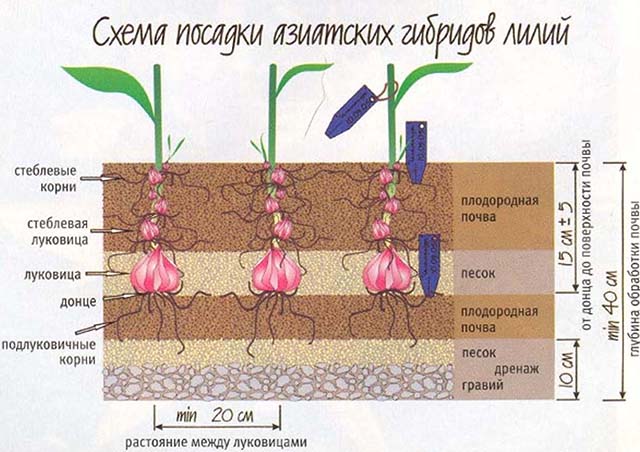
By the way! Before planting, you can pre-treat the lily bulb by soaking it in a potassium permanganate solution or in some kind of disinfectant fungicide.
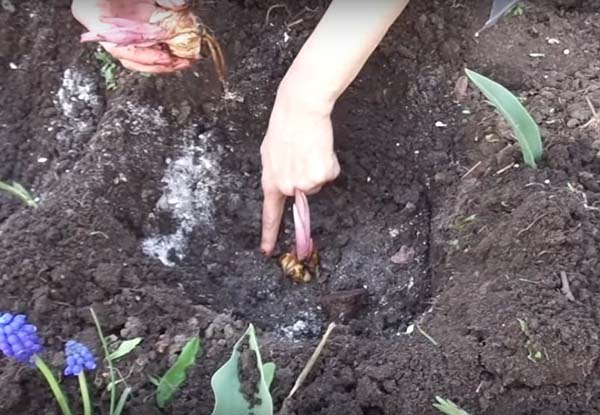
The very process of planting a lily bulb in open ground is simple: just put the bulb with its bottom on the soft bottom of the hole, fix it a little, and then sprinkle it with soil on top. After planting all the bulbs, water the plantings well for their early rooting. If the earth suddenly settles after watering, then do not be afraid to add it to it.
Video: spring planting of lilies
Note! If you plant a lily candidum, then the depth of its landing is somewhat different. In no case should it be planted too deeply, because flower leaves are laid directly above the soil surface. Therefore, the bulb should be covered with soil no more than 2-3 centimeters. Another important nuance is the fact that its planting can be carried out only in spring and summer, it cannot be delayed until autumn. Otherwise, it will not have time to form special wintering leaves, the plant will not be able to winter normally and will die.
A slightly more complex (perhaps more promising) process of preparing a planting pit and planting lilies is offered in the next video, which we still highly recommend you watch.
Video: how to plant lilies in spring
Outdoor care for lilies
Further care for lilies in the garden is quite simple. All these plants need to bloom is regular and moderate enough watering. Remember that these flowers do not tolerate excessive moisture. So, during the flowering period, they especially need watering, but they should be watered abundantly, but not often. But in dry and hot weather, you need to water the lilies more often. When the flowering ends, then watering can be completely stopped.
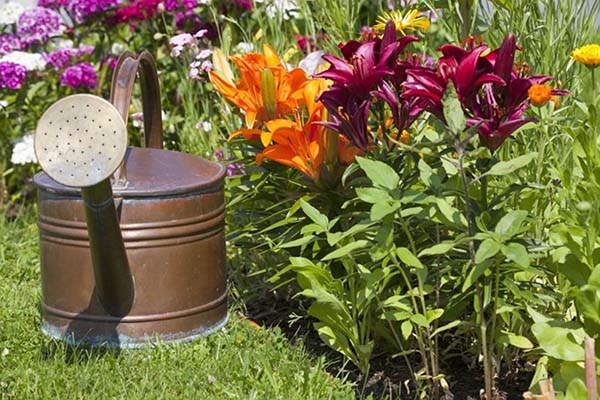
Note! It is impossible to water lilies by sprinkling. It is necessary to introduce moisture clearly to the root, without getting on the leaves, and even more so on the flowers.
It is very convenient to feed lilies with the help of mineral fertilizers. Flowers respond especially well in spring to nitrogen fertilization, eg, ammonium nitrate or urea... And closer to flowering and during it it is good to use a solution wood ash or potassium sulfate (both potash fertilizers).
Advice! Tall varieties of lilies, which have thin stems, are advisable to be tied to supports so that they do not break off and do not die.
The main pest for lilies is the lily beetle, which damages the buds, leaving its ugly moves in them and even eating holes in the leaves. You can get rid of beetles by manually collecting them (preferably in the morning and in cooler weather, when they are less mobile) or by spraying flowers with insecticide preparations such as Inta-Ts-M, Corado, Commander Maxi "," Senpai "and" Aktara ".
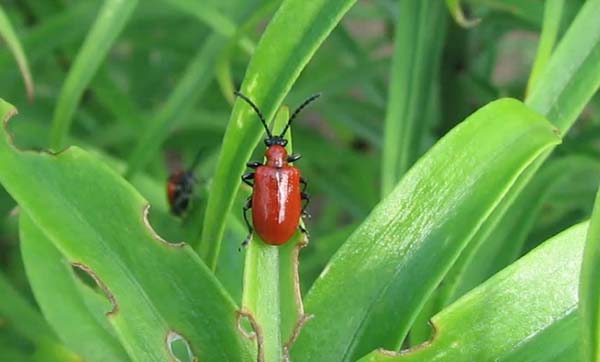
When you cut the lilies, you do not need to do this completely, you need to leave most of the stem. The more leaves you leave, the larger your bulbs will grow. And the larger the bulbs, the more buds you will have on the branch. The cut must be done obliquely. So the rainwater will quickly roll down and not get inside, otherwise it can provoke rotting of the stem.
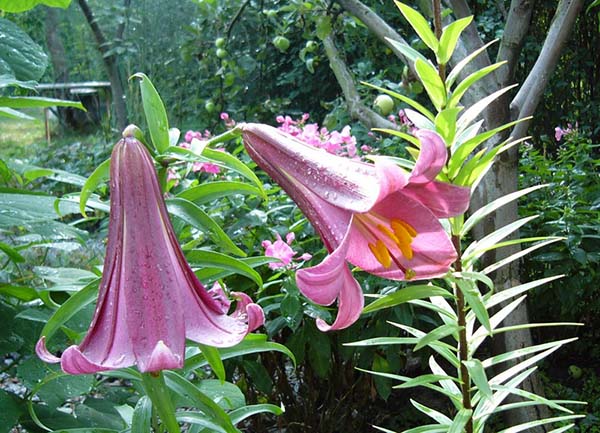
Advice! To prolong the flowering of lilies, remove the stamens from the flowers in a timely manner. It is recommended to do this in the morning.
Video: tips for growing lilies from an experienced gardener
Important! In details about caring for lilies in autumn, as well as preparing them for winter read here.
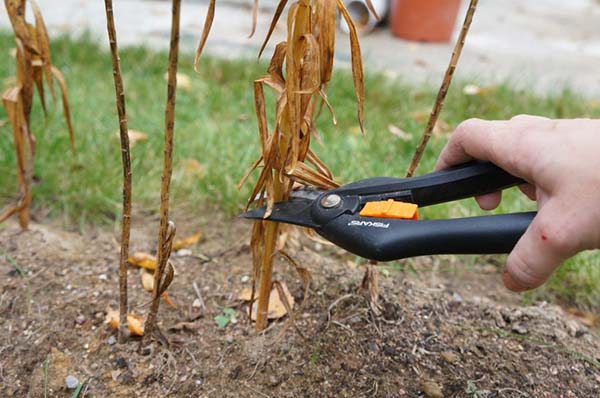
Thus, now you know that planting and growing lilies in your summer cottage is not so difficult, even a novice gardener can handle this. All you need to do is follow these simple guidelines for planting and caring for this beautiful flower. And then its abundant and bright flowering will make your garden even more beautiful.
Video: spring planting of lily bulbs in open ground


Thank you!
Great stuff! Voluminous, important!
Hope, hello!
How to deal with a lily fly? We don't have a beetle, but this infection is making holes in the buds ((
Thank you!
Good day, Julia!
To be honest, I've never come across a lily fly ... I've met a red beetle, which is a lily rattler, but it gnaws at the leaves, doesn't seem to touch the buds.
I read somewhere that you can fight the lily fly in the same ways as with the onion fly.
Have you tried something already, for example, with Aktara?